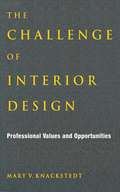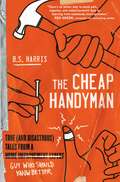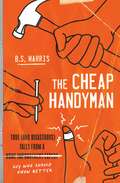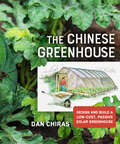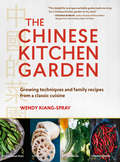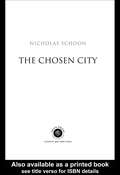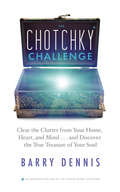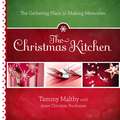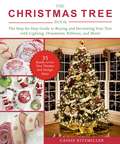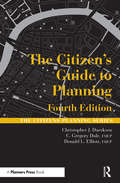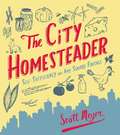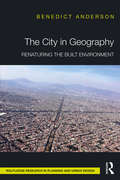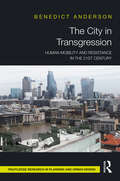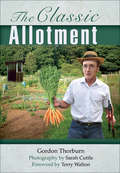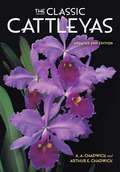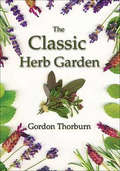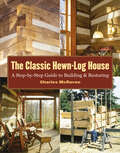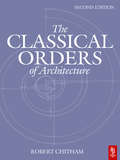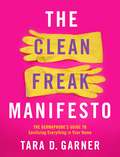- Table View
- List View
The Challenge of Interior Design: Professional Value and Opportunities
by Mary V. KnackstedtKnackstedt, an interior designer and business consultant, takes an eye to changes happening in the interior design field and advises readers how to confront the challenges they entail. The book discusses what is different in the following design-related areas: business theories and today's market, industry, trends, clients' needs, design firms, learning programs, communication, the design team, and specialization.
The Chateau - Forever Home: The final chapter of our greatest adventure
by Dick Strawbridge Angel StrawbridgeReturn to life at Château-de-la-Motte Husson in the concluding memoir from Sunday Times bestselling authors, Dick and Angel Strawbridge.Picking up from where Living the Château Dream ended, Dick and Angel recount the newest and biggest challenges they faced on the journey to transforming their once derelict and abandoned château in France's Pays de la Loire into a thriving family home and sustainable business.When the Covid-19 pandemic engulfs the world, the château faces a new challenge and the Strawbridges must find ways to adapt in order to keep their dream life in France alive. From the cancellation of the wedding season to finding new ways to complete renovations, living in an isolated bubble whilst continuing to film their TV series through to life after the pandemic, this is Dick and Angel at their most honest and heartfelt, revealing many details never seen on TV.As entertaining, warm and irresistible as ever, this is the final chapter in Dick and Angel's remarkable journey to find their family's forever home.
The Cheap Handyman: True (and Disastrous) Tales from a [Home Improvement Expert] Guy Who Should Know Better
by B.S. HarrisHilarious adventures in home renovations and repairs, from a real-life Red Green.Meet Brian Harris, a (mostly) retired, self-proclaimed jack of all trades with a knack for home improvements and inventive money-saving schemes. Armed with a soldering gun, his trusty 9-foot ladder, and of course the handyman&’s secret weapon—duct tape—Brian&’s projects start out as simple chores: trim a tree branch, stain the cedar siding on his home...but all too often they end in costly disaster. Sometimes he&’s trying to do the right thing, like the time he wrecked his pool while saving some baby ducks. Often, he channels his inner MacGyver: he once taped his hockey skate back together so he could finish his rec-league game, only to get suspended for falling on the referee when it broke (again). But usually, he&’s just trying to save a buck, like the time he accidentally destroyed an expensive car key fob because he wouldn&’t pay the (outrageous) $10 fee to have the new battery professionally replaced. Filled with funny and entertaining true stories from the everyday life of an average guy just trying to save a few dollars, The Cheap Handyman is a tribute to anyone who has ever thought, &“Sure! I can do that!&”
The Cheap Handyman: True (and Disastrous) Tales from a [Home Improvement Expert] Guy Who Should Know Better
by B.S. HarrisThis Old House meets #HomeImprovementFails in this collection of laugh-out-loud essays, perfect for fans of Nick Offerman, CarTalk, or The Red Green Show. &“This book is all the fix-it you need for your hurt home improvement ego.&” —Harrison Scott Key, Thurber-prize winning author of The World's Largest ManMeet Brian Harris, a (mostly) retired, self-proclaimed jack of all trades with a penchant for DIY and inventive money-saving schemes. Armed with a soldering gun, his trusty nine-foot ladder, and of course the handyman&’s secret weapon—duct tape—Brian&’s projects start out as simple chores: trim a tree branch, stain the cedar siding on his home...but all too often they end in costly disaster. Sometimes he&’s trying to do the right thing, like the time he wrecked his pool while saving some baby ducks. Often, he channels his inner MacGyver: he once taped his hockey skate back together so he could finish his rec-league game, only to get suspended for falling on the referee when it broke (again). But usually he&’s just being, well, cheap! Like the time he inadvertently destroyed a $295 car key fob because he wouldn&’t pay the (outrageous) $10 fee to have the battery professionally replaced. In The Cheap Handyman, Brian anthologizes his hard-won wisdom, teaching us how (not) to cut down a tree, what to do if a stray cat has kittens in your HVAC system, three very incorrect uses for duct tape, the manifold hazards of pool maintenance, and more. Filled with unforgettable true stories from the everyday life of an average guy just trying to save a few bucks, The Cheap Handyman is a delightful tribute to anyone who has ever thought, &“Sure! I can do that!&”
The Cheat Sheet of Italian Style: Confidence And Sustainable Chic In Ten Struts
by Francesca BelluominiThe reader is catapulted into a life of rousing style filled with carefully-crafted clothing, summer holidays in the Italian countryside, the aroma of fresh tomato sauce simmering in the kitchen, and fresh lavender escaping from grandma's armoire. It transports into a world of desirable glamour, and teaches them how to achieve the same understated chicness Italians are recognized for regardless of nationality, age or budget. You'll learn how not to follow trends, how to borrow from the boys' closet and why lingerie is for you and not him.
The Chihuahua (Learning About Dogs)
by Charlotte WilcoxThis book is a good guide for children who are interested in getting a small dog. It also covers the basic information adults might want to know, although it is geared for young children.
The Chinese Greenhouse: Design and Build a Low-Cost, Passive Solar Greenhouse (Mother Earth News Books for Wiser Living)
by Dan Chiras“A prescription for survival in this gorgeously illustrated and accessible guide to the future of farming.” —Albert Bates, author of The Biochar SolutionGrow vegetables year-round in a greenhouse powered only by solar energy!Originally developed in China to feed millions, Chinese greenhouses are earth-sheltered, solar-heated, east-west oriented, intelligently glazed, and well-insulated. They have proven highly effective in growing warm-weather vegetables and fruits like green peppers and tomatoes in cold climates through fall, winter, and early spring using passive solar energy as the sole heat source.The Chinese Greenhouse is a full-color comprehensive guide to these passive solar greenhouses for self-sufficiency and growing year-round in soil or aquaponic grow beds with no additional heat. Coverage includes:How to design, build, and operate a Chinese greenhouseHow to improve performance via short-term and long-term heat bankingHow to provide additional heat to make your greenhouse operate even more effectivelyHow to cool the greenhouse during the summer.Become a more self-sufficient gardener, growing and harvesting a variety of fresh fruits and vegetables year-round, with your own Chinese greenhouse.“Wonderfully researched . . . brilliant.” —Jean-Martin Fortier, farmer and author of The Market Gardener, editor of Growers Magazine“Essential reading for pioneers of Chinese greenhouses.” —Pam Dawling, author of The Year-Round Hoophouse and Sustainable Market Farming“Every enthusiastic vegetable farmer dreams of this winter-growing miracle, and Dan shows how to do it.” —Shawna Coronado, author of 101 Organic Gardening Hacks
The Chinese Kitchen Garden: Growing Techniques and Family Recipes from a Classic Cuisine
by Wendy Kiang-SprayWinner of the Garden Writers Association 2018 Silver Medal of Achievement Wendy Kiang-Spray’s family has strong culinary and gardening traditions. In The Chinese Kitchen Garden, she beautifully blends the story of her family’s cultural heritage with growing information for 38 Chinese vegetables—like lotus root, garlic, chives, and eggplant—and 25 traditional recipes like congee, dumplings, and bok choy stir-fry. Organized by season, you’ll learn what to grow in spring and what to cook in winter.
The Chosen City
by Nicholas SchoonThere is endless talk about the need for an urban renaissance; can it happen in the real world? In this broad, challenging and highly engaging book, Nicholas Schoon argues that the foremost priority for regeneration is to make neighbourhoods and cities places where people with choices choose to live.The author surveys the last two centuries of metropolitan growth and decay, analyzes the successes and failures of recent changes in urban policy and proposes a wide range of radical measures to make the renaissance a reality. Comprehensively researched, The Chosen City is a wake up call for everyone interested and involved in urban regeneration - degree students and academics, planning and housing professionals, architects, surveyors, developers and politicians. The text is illustrated with powerful black and white images from a leading national newspaper photographer.
The Chotchky Challenge: Clear The Clutter From Your Home, Heart, And Mind... And Discover The True Treasure Of Your Soul
by Barry DennisChotchky is a variation of a Yiddish word typically referring to something of little value . . . but it can also mean something much more profound. It’s the excess "stuff" that we’ve accumulated in our homes and hearts—the meaningless possessions, negative beliefs, self-doubts, and toxic relationships that drain our time, energy, and money. The challenge is to identify our chotchkies and understand how they’ve infiltrated our lives and lulled us to sleep. Our soul tries to get our attention through our subtle thoughts and feelings that seem to whisper, There is more to life than this. But our chotchkies keep coming, filling us with a false sense of purpose. <P><P>In this deeply insightful and often humorous work, spiritual teacher Barry Dennis shows you how to attain complete and total freedom from all of your chotchkies. When you’re free, you will come face-to-face with the true nature of your soul and finally be able to focus on what really matters. This won’t be easy . . . but just because something isn’t easy doesn’t mean it can’t also be fun. <P>Your soul awaits. Become part of a new paradigm that is leading the way to a more balanced and peaceful world. It’s time to take the chotchky challenge!
The Christmas Kitchen: The Gathering Place for Making Memories
by Tammy MaltbyThis Christmas collection, enhanced with four-color photographs, includes recipes, gift ideas, decorating tips, and hints to involve the whole family. It’s the perfect gift or self-purchase for anyone who loves Christmas and all the traditions it brings.The kitchen is the heart of the home and when Christmas rolls around, the kitchen is where everyone gathers for hot chocolate, apple cider, and cookies that look like angels. The Christmas Kitchen celebrates the gathering place everyone can relate to with decorating tips, gift ideas, recipes, meditations, and much more. Tammy Maltby believes the true meaning of Christmas begins with the family sharing easy-to-do activities that will bring everyone together in a glow as warm as the kitchen fire itself. Four-color photographs enhance each chapter and create a Christmas book that readers will cherish.
The Christmas Tree Book: The Step-by-Step Guide to Buying and Decorating Your Tree with Lighting, Ornaments, Ribbons, and More!
by Cassie KitzmillerInterior designer Cassie Kitzmiller shows you how to decorate the perfect Christmas tree this holiday season with step-by-step instructions and beautiful photos for design inspiration! Have you ever found yourself staring at your bare Christmas tree wondering: How many lights am I supposed to put on my tree to prevent dark spots? What exactly is supposed to go on the top and how am I supposed to get it to stay in place? How do I get my tree to look full and beautiful? What should I put on my tree and in what order? What am I supposed to do with all this stuff once the holidays are over? In The Christmas Tree Book, author and interior designer Cassie Kitzmiller pulls from over a decade of professional holiday decorating experience to provide you with everything you need to design your best looking Christmas tree ever! Throughout the book, Cassie shares with you the materials, techniques, and time-saving shortcuts that she uses to design show-stopping trees. Included in The Christmas Tree Book: Choosing between real and artificial treesSelecting a decoration themePicking out ornaments, garlands, tree toppers, and moreClosely-held industry designer secrets! Whether you&’re a Christmas novice starting out on your first tree or a seasoned veteran looking for a bit of inspiration, The Christmas Tree Book has you covered. No matter your skill level, if you&’re thinking of decorating this holiday season, this book is an essential guide to an amazing Christmas tree in your home.
The Chrysanthemum in Japanese Design: 121 Patterns and Motifs
by Kawarasaki KotoImported from China during the 8th century, the chrysanthemum is the official flower of Japan. The Japanese monarchy is known as The Chrysanthemum Throne, and the exquisite blossom is widely revered as a symbol of longevity, dignity, and nobility. This volume, reproduced from a rare and expensive publication, features more than 120 color woodblock images of the breathtaking perennials.
The Château - Forever Home: The instant Sunday Times Bestseller, as seen on the hit Channel 4 series Escape to the Château
by Dick Strawbridge Angel StrawbridgeTake a journey to Château-de-la-Motte Husson in the spellbinding memoir from Sunday Times bestselling authors, Dick and Angel Strawbridge.Dick and Angel recount the newest and biggest challenges they faced on the journey to transforming their once derelict and abandoned château in France's Pays de la Loire into a thriving family home and sustainable business.When the Covid-19 pandemic engulfs the world, the château faces a new challenge and the Strawbridges must find ways to adapt in order to keep their dream life in France alive. From the cancellation of the wedding season to finding new ways to complete renovations, living in an isolated bubble whilst continuing to film their TV series through to life after the pandemic, this is Dick and Angel at their most honest and heartfelt, revealing many details never seen on TV.As entertaining, warm and irresistible as ever, Join Dick and Angel on their remarkable journey to find their family's forever home.
The Citizen's Guide to Planning
by Christopher Duerksen Gregory C Dale Donald L ElliottAPA's popular primer for citizens is all new! For decades, planning officials and engaged citizens have relied on this book for a better understanding of the basics of planning. Now the authors have revised this perennial bestseller into a 21st-century guide for anyone who wants to make his or her community a better place. This book describes the land-use planning process, the key players in that process, and the legal framework in which decisions are made. The authors advocate principles and disciplines that will help those involved in the process make good decisions. In easy-to-understand language, they offer nuts-and-bolts information about different types of plans and how they are implemented. Chapters cover the goals and values of planning, the history of planning, the different people and organizations involved, the creation and implementation of a comprehensive plan, sustainability, the application review process, and legal and ethical questions.
The City Homesteader: Self-Sufficiency on Any Square Footage
by Scott MeyerThe City Homesteader is the handbook for the world of self-sufficient living. It's about living tangibly in a virtual world. It's about being resourceful, saving money, reducing consumption, and increasing self-reliance. Join the many who are raising backyard chickens in the city and tilling their side yards: tapping into natural energy, managing homes more efficiently, and getting back to the earth. Explore the homesteading arts: gardening on small and large scales, raising dwarf fruit trees, sprouting grains, smoking meats and fish, grinding grains for flour, making cheese, making wine, cellaring, heating without fossil fuel, harvesting rainwater, composting, and much moreThe City Homesteader provides all the basics, including how to find supplies and step-by-step instructions that make it easy to follow along. Original illustrations throughout help you create your very own homestead on any piece of earth.
The City in Geography: Renaturing the Built Environment
by Benedict AndersonMonumental in scale and epic in development, cities have become the most visible and significant symbol of human progress. The geography on and around which they are constructed, however, has come to be viewed merely in terms of its resources and is often laid to waste once its assets have been stripped. The City in Geography is an urban exploration through this phenomenon, from settlement to city through physical geography, which reveals an incremental progression of removing terrain, topography and geography from the built environment, ushering in and advancing global destruction and instability. This book explains how the fall of geography in relationship to human survival has come through the loss of contact between urban dwellers and physical terrain, and details the radical rethinking required to remedy the separations between the city, its inhabitants and the landscape upon which it was built.
The City in Transgression: Human Mobility and Resistance in the 21st Century
by Benedict AndersonThe City in Transgression explores the unacknowledged, neglected, and ill-defined spaces of the built environment and their transition into places of resistance and residence by refugees, asylum seekers, migrants, the homeless, and the disadvantaged. The book draws on urban and spatial theory, socio-economic factors, public space, and architecture to offer an intimate look at how urban sites and infrastructure are transformed into spaces for occupation. Anderson proposes that the varied innovations and adaptations of urban spaces enacted by such marginalized figures – for whom there are no other options – herald a radical new spatial programming of cities. The book explores cities and sites such as Mexico City and London, the Mexican/US border, the Calais Jungle, and Palestinian camps in Beirut and utilizes concepts associated with ‘mobility’ – such as anarchy, vagrancy, and transgression – alongside photography, 3D modelling, and 2D imagery. From this constellation of materials and analysis, a radical spatial picture of the city in transgression emerges. By focusing on the ‘underside of urbanism’, The City in Transgression reveals the potential for new spatial networks that can cultivate the potential for self-organization so as to counter the existing dominant urban models of capital and property and to confront some of the major issues facing cities amid an age of global human mobility. This book is valuable reading for those interested in architectural theory, modern history, human geography and mobility, climate change, urban design, and transformation.
The Classic Allotment
by Gordon Thorburn Sarah Cuttle Terry WaltonAllotments are enjoying a renewed popularity because people want to know exactly what theyre eating, save money, eat seasonally and save on carbon footprints. As well as men, more and more women are taking up the challenge to create their own sustainable food source with allotments, as well as experiencing the enjoyment of seeing things grow, not just fruit and vegetables, but also flowers. As well as potatoes and sunflowers, exotic plants such as ginger and pak choi are being grown and people are running businesses from their allotment produce, tapping into the locally-sourced, seasonal food market. Gordon Thorburn shows how to make the best from your allotment or even a veg patch with tips on natural bug deterrents, companion planting (save your cabbages by planting marigolds amongst them) and a handy seasonal planner, as well as must-try recipes.
The Classic Cattleyas
by A. A. Chadwick Arthur E. ChadwickIn 1818, William Cattley succeeded in flowering one of the first species of the genus that would bear his name. These first cattleyas are the classic cattleyas, whose form defined the essence of tropical orchids for generations to come. Indeed, the color of their flowers became known as "orchid." In this helpful and informative book, each classic Cattleya species is described in fascinating detail, and its role in breeding programs is elucidated. All that is required to appreciate and grow the large-flowered cattleyas successfully is included. Cultivation, humidity and watering, fertilizing, propagation, and diagnosing and treating problems are detailed, making this volume valuable for both veteran orchid enthusiasts and those who simply love these beautiful flowers.
The Classic Herb Garden
by Gordon ThorburnA helpful guidebook to growing herbs successfully and safely, with photos included. Herbs have been used since ancient times both to flavor food and as natural medicines. In this easy-access guide, gardener Gordon Thorburn reveals different types of herb gardens to suit your needs—from those that don’t require a lot of attention (mint and rosemary don’t need much watering, but basil and the beautiful Vietnamese coriander are very demanding), to classic herb gardens, culinary options, and medicinal herb gardens. Whether you suffer from migraines, insomnia, coughs and colds, or fatigue, there are herbs which can treat you without side effects. But some herbs can prove fatal—so you can also discover which herbs are safe to use as herbal teas, but not as salad leaves, in this guide to creating the perfect herb garden for your needs. Each herb is listed with growing instructions and its culinary and medicinal uses, plus the color of its flowers and any must-know information, from health warnings to nature-friendly herbs which attract butterflies and bees to help pollinate your garden.
The Classic Hewn-Log House: A Step-by-Step Guide to Building and Restoring
by Charles McRavenA classic of early American architecture, the hewn-log house has a unique rustic charm and character. In this engaging and informative guide, Charles McRaven provides illustrated step-by-step instructions that cover every aspect of building your own log house, from selecting the site and hewing the first log to laying the final chimney stone. Whether you’re building a new house or restoring an old one, McRaven offers proven techniques and time-tested advice that will help you successfully create a warm and inviting hewn-log home.
The Classical Orders of Architecture
by Robert ChithamThis is the only publication that presents a modern interpretation of the Classical Orders. The new edition of this successful title now includes the proportions in both metric and imperial measurements to make the orders more accessible and to provide a valuable reference for designers.The inclusion of both 100-part and 96-part systems of proportion is underpinned by an essay on James Gibbs - one of the 18th century authors of standardized proportioning systems - and his influence in America. Along with additional plates, this book gives aclear introduction to those not familiar with the classical genre and is an easy to follow guide which assists architects, interior designers and conservators with the quality of their design.
The Clean Freak Manifesto: The Germaphobe's Guide to Sanitizing Everything in Your Home
by Tara D. GarnerGo beyond sparkling clean for a safe sparkling clean!Tara D. Garner's The Clean Freak Manifesto covers everything you need to know in order to keep your entire home truly sanitized and healthy amid the ever-changing world of viruses and bacteria. So stop panic-cleaning with bleach when someone suddenly gets sick or the headlines discover a new health threat. Instead, get prepared now with sensible steps that will work hard for your household all year round.- Discover the hot spots where germs lurk—so you can target your efforts- Understand the difference between cleaning and disinfecting—and the common mistakes that leave us unprotected- Get cleaning secrets for tough places—from electronics to the laundry room- Find shortcuts and natural cleaners that give you options to meet your needs- Stay protected on the go and keep germs from entering your home with sanitizing strategies for the workplace, errands, takeout and deliveries, and travel- Save money with easy DIY disinfecting solutions and tips for buying the most effective commercial cleanersWith The Clean Freak Manifesto you’ll feel smart, prepared, and safe as your germ anxiety eases and you take control!
The Cleaning Encyclopedia: America’s # Cleaning Expert
by Don AslettThe ultimate guide to the art of cleaning, this reference is packed with professional secrets for getting maximum results through minimum results through minimum effort. Discover how to save time, money, and elbow grease on every cleaning problem, as well as how to prevent housework with surprising tricks of the trade. From aluminum siding to zoom lenses, this alphabetical index covers every job, big and small.
